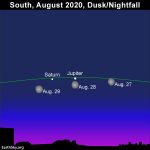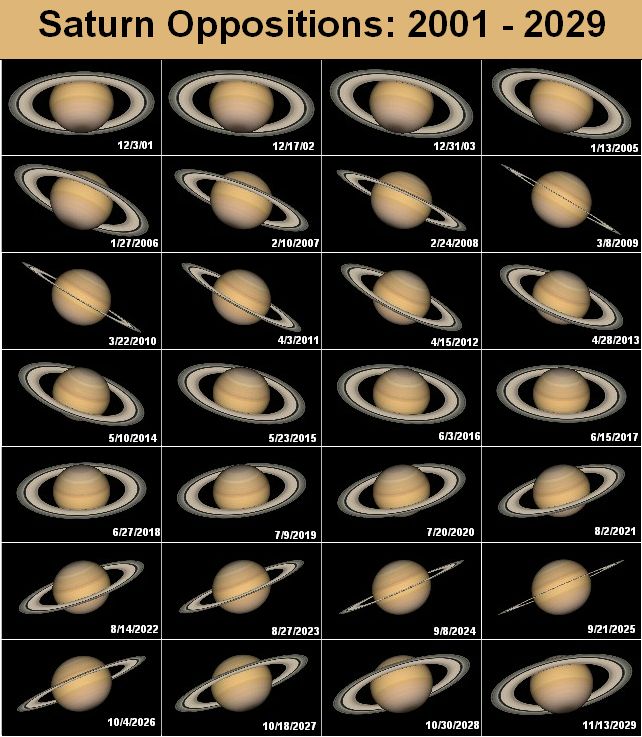
These next several evenings – August 27, 28 and 29, 2020 – watch for the waxing gibbous moon to pass by the 2 biggest planets in our solar system, Jupiter and Saturn. Both worlds are gas giants. Jupiter is by far the brighter planet, shining some 8 times more brilliantly than Saturn. Yet the famous planet of the rings shines as brightly as the brightest stars. Just look up on these nights! You can’t miss these bright worlds near the moon.
Jupiter ranks as the 4th-brightest celestial body to light up the heavens, after the sun, moon and the planet Venus. But there’s no way to mistake Venus for Jupiter, or vice versa, because – at present – Jupiter rules the evening sky while Venus is up at dawn. Around the world, in the wee hours of the morning, Jupiter sets in southwest at roughly the same time that Venus rises in the northeast.
Meanwhile, Saturn – the most distant word that you can see easily with the unaided eye – is twice as bright as the 1st-magnitude star Antares, Heart of the Scorpion. You might have seen the moon in the vicinity of Antares a few days ago.
Live in the US or Canada? Find out when Jupiter sets and Venus rises via Old Farmer’s Almanac.
For virtually anywhere worldwide, find out when Jupiter sets and Venus rises via TimeandDate.
Click on Heaven-Above Moon for the moon’s present position on the zodiac

Here’s a constellation to look for near the moon, Jupiter and Saturn in the next few days. Scorpius is one of the few constellations that looks like its namesake. The bright red star Antares marks the Scorpion’s Heart. On the night of August 27, an imaginary line drawn from Jupiter and past the moon points to Antares. Also, notice the 2 stars at the tip of the Scorpion’s Tail. These 2 stars – Shaula and Lesath – are known as The Stinger.
There are two reasons for Jupiter and Saturn’s brilliance. First of all, these planets are huge; and, secondly, they have a high albedo (reflectivity). Jupiter has 1,331 times the volume of Earth, whereas Saturn has 764 times the Earth’s volume. Jupiter reflects about 52 percent of the incoming sunlight, while Saturn reflects about 47 percent. In contrast, our moon only reflects about 12 percent of the incoming sunlight.
Unlike the stars, which shine by their own light, Jupiter and Saturn shine by reflecting the light of the sun. Despite Jupiter residing 4.4 astronomical units (AU) from Earth and Saturn at 9.2 AU from Earth right now, these planets still stand out in Earth’s sky. By the way, one AU = one sun/Earth distance.
Find out planetary distances from Earth and the sun via Heavens-Above.
Saturn’s brilliance also depends the tilt of its majestic rings. You need a telescope to view the rings, but their inclination affects the planet’s brightness as seen from Earth, when looking with the eye alone. Saturn appears brightest when the rings are inclined at a maximum of 27 degrees toward Earth, and dimmest when the rings appear edge-on (0 degrees).
Presently, the rings are inclined at little more than 21 degrees, adding to Saturn’s overall brilliance.

Image via Wikimedia Commons. The tilt of Saturn’s rings has a great impact on its overall brightness. In years when Saturn’s rings are edge-on as seen from Earth (2009 and 2025), Saturn appears considerably dimmer than in years when Saturn’s rings a maximally titled toward Earth (2017 and 2032). This year, in 2020, Saturn’s rings are still quite inclined.
Bottom line: On August 25, 26 and 27, 2020, use the moon locate the two largest planets of the solar system, Jupiter and Saturn.
from EarthSky https://ift.tt/2G5rMKp

These next several evenings – August 27, 28 and 29, 2020 – watch for the waxing gibbous moon to pass by the 2 biggest planets in our solar system, Jupiter and Saturn. Both worlds are gas giants. Jupiter is by far the brighter planet, shining some 8 times more brilliantly than Saturn. Yet the famous planet of the rings shines as brightly as the brightest stars. Just look up on these nights! You can’t miss these bright worlds near the moon.
Jupiter ranks as the 4th-brightest celestial body to light up the heavens, after the sun, moon and the planet Venus. But there’s no way to mistake Venus for Jupiter, or vice versa, because – at present – Jupiter rules the evening sky while Venus is up at dawn. Around the world, in the wee hours of the morning, Jupiter sets in southwest at roughly the same time that Venus rises in the northeast.
Meanwhile, Saturn – the most distant word that you can see easily with the unaided eye – is twice as bright as the 1st-magnitude star Antares, Heart of the Scorpion. You might have seen the moon in the vicinity of Antares a few days ago.
Live in the US or Canada? Find out when Jupiter sets and Venus rises via Old Farmer’s Almanac.
For virtually anywhere worldwide, find out when Jupiter sets and Venus rises via TimeandDate.
Click on Heaven-Above Moon for the moon’s present position on the zodiac

Here’s a constellation to look for near the moon, Jupiter and Saturn in the next few days. Scorpius is one of the few constellations that looks like its namesake. The bright red star Antares marks the Scorpion’s Heart. On the night of August 27, an imaginary line drawn from Jupiter and past the moon points to Antares. Also, notice the 2 stars at the tip of the Scorpion’s Tail. These 2 stars – Shaula and Lesath – are known as The Stinger.
There are two reasons for Jupiter and Saturn’s brilliance. First of all, these planets are huge; and, secondly, they have a high albedo (reflectivity). Jupiter has 1,331 times the volume of Earth, whereas Saturn has 764 times the Earth’s volume. Jupiter reflects about 52 percent of the incoming sunlight, while Saturn reflects about 47 percent. In contrast, our moon only reflects about 12 percent of the incoming sunlight.
Unlike the stars, which shine by their own light, Jupiter and Saturn shine by reflecting the light of the sun. Despite Jupiter residing 4.4 astronomical units (AU) from Earth and Saturn at 9.2 AU from Earth right now, these planets still stand out in Earth’s sky. By the way, one AU = one sun/Earth distance.
Find out planetary distances from Earth and the sun via Heavens-Above.
Saturn’s brilliance also depends the tilt of its majestic rings. You need a telescope to view the rings, but their inclination affects the planet’s brightness as seen from Earth, when looking with the eye alone. Saturn appears brightest when the rings are inclined at a maximum of 27 degrees toward Earth, and dimmest when the rings appear edge-on (0 degrees).
Presently, the rings are inclined at little more than 21 degrees, adding to Saturn’s overall brilliance.

Image via Wikimedia Commons. The tilt of Saturn’s rings has a great impact on its overall brightness. In years when Saturn’s rings are edge-on as seen from Earth (2009 and 2025), Saturn appears considerably dimmer than in years when Saturn’s rings a maximally titled toward Earth (2017 and 2032). This year, in 2020, Saturn’s rings are still quite inclined.
Bottom line: On August 25, 26 and 27, 2020, use the moon locate the two largest planets of the solar system, Jupiter and Saturn.
from EarthSky https://ift.tt/2G5rMKp

Aucun commentaire:
Enregistrer un commentaire